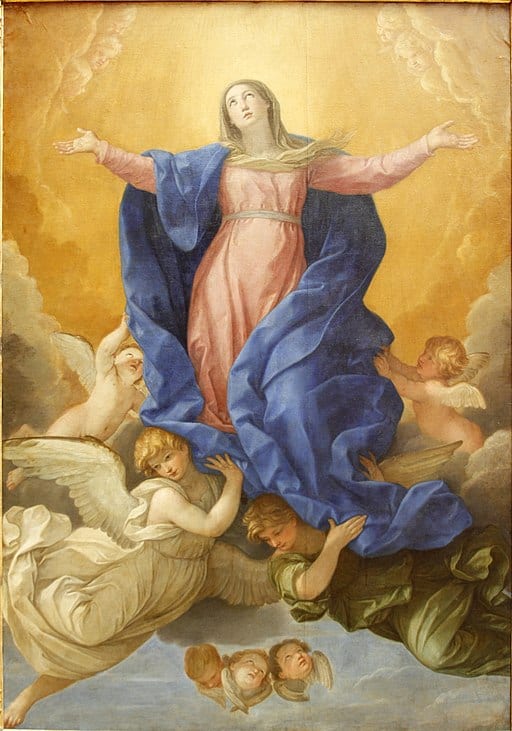Assumption of Mary
Fourth Glorious Mystery of the Rosary

Introduction
The fourth Glorious Mystery of the Rosary is the Assumption of Mary, a momentous event in Christian theology. This doctrine holds that Mary, the mother of Jesus, was taken body and soul into heaven at the end of her earthly life. The importance and significance of the Assumption lie in its affirmation of Mary’s unique role in the divine plan and her closeness to her son, Jesus Christ.
The Assumption underscores Mary’s sinlessness and her intimate connection with the redemptive work of Jesus. By being assumed into heaven, Mary is believed to have already experienced the fullness of salvation that awaits all believers in Christ. This event emphasizes the dignity of Mary as the Mother of God and reinforces her role as a model of faith and discipleship for the Christian community.
The Assumption of the Blessed Virgin Mary also highlights the sanctity of the human body. In Mary’s assumption, the physical aspect of her being is not left behind but is glorified in unity with her soul. This anticipates the Christian belief in the resurrection of the body at the end of time.
Ultimately, the Assumption of the Blessed Virgin Mary is a celebration of divine grace, emphasizing the profound bond between the mother and the son, and it offers believers a glimpse into the heavenly glory that awaits those who follow Christ faithfully.
Scriptures of the Assumption of Mary
Judith 13:18-20, 15:10
And by me his handmaid he hath fulfilled his mercy, which he promised to the house of Israel: and he hath killed the enemy of his people by my hand this night. Then she brought forth the head of Holofernes out of the wallet, and shewed it them, saying: Behold the head of Holofernes the general of the army of the Assyrians, and behold his canopy, wherein he lay in his drunkenness, where the Lord our God slew him by the hand of a woman. But as the same Lord liveth, his angel hath been my keeper both going hence, and abiding there, and returning from thence hither: and the Lord hath not suffered me his handmaid to be defiled, but hath brought me back to you without pollution of sin, rejoicing for his victory, for my escape, and for your deliverance.
Judith 15:10
And when she was come out to him, they all blessed her with one voice, saying: Thou art the glory of Jerusalem, thou art the joy of Israel, thou art the honor of our people: For thou hast done manfully, and thy heart has been strengthened, because thou hast loved chastity, and after thy husband hast not known any other: therefore also the hand of the Lord hath strengthened thee, and therefore thou shalt be blessed forever. And all the people said: So be it, so be it.
Scripture Commentary
Judith 13:18-20 is a passage from the Book of Judith in the Old Testament. In this passage, Judith, a courageous and pious widow, has just slain the Assyrian general Holofernes, who posed a threat to her people. The verses describe the aftermath of this significant event.
In these verses, Uzziah, a leader among the Israelites, praises Judith for her bravery and attributes her success to the guidance of the Most High God. He acknowledges her as blessed among women and expresses gratitude for her role in saving their nation from impending danger. The passage emphasizes the idea that Judith’s courageous actions were not only a personal triumph but also a divine intervention that averted disaster for her people.
Judith 15:10 is a verse from the Book of Judith in the Old Testament. This verse comes towards the end of the book and describes the aftermath of Judith’s victory over the Assyrian army.
In this verse, the people who witnessed Judith’s triumph over the Assyrians are filled with astonishment and gratitude. They collectively bow down and worship God, recognizing the divine intervention that led to the defeat of their enemies. The verse emphasizes the unity of the people in acknowledging God’s role in the victory and expressing their blessings for the deliverance from their adversaries. It reflects a moment of communal worship and thanksgiving for the miraculous events that unfolded, highlighting the theme of divine assistance and the people’s recognition of God’s power in times of crisis.
Feast Day of the Assumption of the Blessed Virgin Mary
The Feast of the Assumption of Mary is a special day in the Catholic Church that commemorates the belief that Mary, the mother of Jesus, was taken up into heaven, both in body and soul, at the end of her earthly life. This event is not explicitly described in the Bible, but it is a longstanding tradition in Catholic theology.
The Assumption highlights Mary’s unique role and closeness to her son, Jesus Christ. According to Catholic belief, Mary’s assumption into heaven is a sign of her special favor with God and her participation in the glory of the resurrection. The feast, celebrated on August 15th, is a time for Catholics to reflect on Mary’s significance in their faith and to honor her as a model of faith, humility, and devotion. It is a day of joy and reverence for Mary’s exalted position in Christian theology.
Download our Glorious Mysteries pdf Document
We have a Glorious Mysteries pdf available for your use. It is free to download and share. It can be printed and used for praying the Rosary and is an excellent aid for anyone, especially for beginners. The author still uses it to this day.
To view our Glorious Mysteries pdf page, click the link. To go straight to the pdf, click the button below.

We strive to provide the most complete and highest quality material we can for you, our readers. Although not perfect,
it is our desire and prayer that you benefit from our efforts.
Last Publish: February 5, 2024

